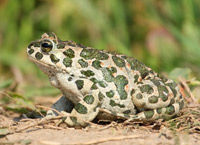Unexpected fossil discovery in Spain raises a new question about the green toad.
Click image to enlarge The green toad (Bufo viridis) is one of the most widely-distributed amphibians. |
Although the green toad (Bufo viridis) is one of the most widely-distributed amphibians in the world today, being found all over central Europe, Asia, Africa, and even on the Balearic Islands in the Mediterranean, there is one area where it is conspicuously absent – on the Iberian Peninsula.
However, recent analysis of fossils found in the Cueva Victoria deposit around the city of Cartagena in southeastern Spain has now, for the first time, confirmed the presence of the green toad species in this region. The remains date back to the end of the Early Pleistocene, more than 1.1 million years ago.
Analysis of Fossils
"Around 500 fossilized bones documenting the entire skeleton of the green toad were unearthed, and provide key osteological clues that mean these remains can be unequivocally attributed to this species", said Hugues-Alexandre Blain, one of the authors of the study and a researcher in the Prehistory Department at the Rovira i Virgili University (URV) in Tarragona.
Up until now, the presence of this green toad species had never been demonstrated in the Iberian Peninsula. The study shows that these green toads belonged to a different subspecies, however, compared with the green toads of today.
"Although the peninsula does have seemingly favorable ecological conditions for these toads, the species is strangely absent," Blain said.
The southwestern limit of the green toad’s current range in Europe is the border between Italy and France. In Spain, the green toad species is only found in the Balearic Islands, where it is thought to be a relatively recent arrival from North Africa. The green toad was possibly introduced there by the Phoenicians, who were seafarers from North Africa, and traded widely throughout the Mediterranean region some 3,000 years ago.
Disappearance
There are various theories as to why the green toad disappeared from the Iberian Peninsula during the Pleistocene epoch. Changes in the climate and landscape have taken place frequently over the past two million years.
"Climate changes and in particular the cold period seen around one million years ago could be possible explanations," Blain said.
However, pressure from its closest living relative, the natterjack toad (Bufo calamita), which is recognized as a stronger species, may also have served to displace the green toad. This could be the reason for the extinction of some local populations. Blain said that "we will only be able to find out what really caused the local extinction of B. viridis by carrying out studies on more deposits, covering a more extensive geographical area and a longer time period."
Reference
Hugues-Alexandre Blain, Luis Gibert, Carles Ferràndez-Cañadell. First report of a green toad (Bufo viridis sensu lato) in the Early Pleistocene of Spain: Palaeobiogeographical and palaeoecological implications. Comptes Rendus Palevol, 2010; 9 (8): 487.


